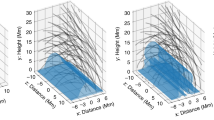Abstract
An emission measure analysis is performed for the Prominence-Corona Transition Region (PCTR) under the assumption that the cool matter of quiescent filaments is contained in long, thin magnetic flux loops imbedded in hot coronal cavity gas. Consequently, there is a transition region around each thread.
Comparison of the model and observations implies that the temperature gradient is perpendicular to the magnetic lines of force in the lower part of the PCTR (T < 105 K). It is shown that in this layer the heating given by the divergence of the transverse conduction fails to account for the observed UV and EUV emission by several orders of magnitude. It is, therefore, suggested that the heating of these layers could be due to dissipation of Alfvén waves.
In the high-temperature layers (T ≥ 105 K), where the plasma β ≥ 1, the temperature gradient is governed by radiative cooling balancing conductive heating from the surrounding hot coronal gas. Also in these outer layers the presence of magnetic fields reduces notably the thermal conduction relative to the ideal field-free case. Numerical modelling gives good agreement with observed DEM; the inferred value of the flux carried by Alfvén waves, as well as that of the damping length, greatly support the suggested form of heating. The model assumes that about 1/3 of the volume is occupied by threads and the rest by hot coronal cavity matter.
The brightness of the EUV emission will depend on the angle between the thread structure and the line of sight, which may lead to a difference in brightness from observations at the limb and on the disk.
Similar content being viewed by others
References
Athay, R. G.: 1982, Astrophys. J. 263, 390.
Califano, F., Chiuderi, C., and Einaudi, G.: 1990, Astrophys. J. 365, 757.
Cally, P. S.: 1990, Astrophys. J. 355, 693.
Chiuderi, C. and Chiuderi Drago, F.: 1991, Solar Phys. 132, 81.
Dere, K. P., Bartoe, J.-D. F., and Brueckner, G. E.: 1986, Astrophys. J. 305, 947.
Dunn, R. B.: 1960, Ph.D. Thesis, Harvard University, Harvard.
Einaudi, G. and Raadu, M. A.: 1987, in J. L. Ballester (ed.), Proc. Workshop on Dynamics and Structure of Solar Prominences, Palma, Mollarco, p. 161.
Engvold, O. and Kjeldseth-Moe, O.: 1990, in P. Maltby and E. Leer (eds.), Proceedings of the Mini-Workshop on Physical Processes in the Solar Transitions-Region and Corona, Institute of Theoretical Astrophysics, University Oslo, p. 165.
Engvold, O., Kjeldseth-Moe, O., Bartoe, J.-D. F., and Brueckner, G. E.: 1987, Proc. 21st ESLAB Symposium, Bolkesjø, Norway, ESA SP-275, p. 21.
Engvold, O., Hansteen, V., Kjeldseth-Moe, O., and Brueckner, G. E.: 1989, in V. Ruždjak and E. Tandberg-Hanssen (eds.), ‘Dynamic of Quiescent Prominences’, Proc. IAU Colloq. 117, 250.
Fontenla, J. M. Avrett, E. H., and Loeser, R.: 1990, Astrophys. J. 355, 700.
Jensen, E.: 1989, in V. Ruždjak and E. Tandberg-Hanssen (eds.), ‘Dynamics of Quiescent Prominences’, Proc. IAU Colloq. 117, 106.
Kim, I. S.: 1989, in V. Ruždjak and E. Tandberg-Hanssen (eds.), ‘Dynamics of Quiescent Prominences’, Proc. IAU Colloq. 117, 49.
Kjeldseth-Moe, O., Cook, J. W., and Mango, S. A.: 1979, Solar Phys. 61, 319.
Kuin, N. P. M. and Poland, A. I.: 1991, Astrophys. J. 370, 763.
Kundu, M. R., Melozzi, M., and Shevgaonkar, R. K.: 1986, Astron. Astrophys. 167, 166.
Mariska, J. T.: 1986, Ann. Rev. Astron. Astrophys. 24, 23.
Martin, S. F.: 1989, in V. Ruždjak and E. Tandberg-Hanssen (eds.), ‘Dynamics of Quiescent Prominences’, Proc. IAU Colloq. 117, 106.
Poland, A. I. and Engvold, O.: 1986, unpublished results from SMM data.
Pramesh Rao, A. and Kundu, M. R.: 1977, Solar Phys. 55, 161.
Priest, E. R.: 1982, Solar Magnetohydrodynamics, D. Reidel Publ. Co., Dordrecht, Holland.
Raymond, J. C. and Smith, B. W.: 1977, Astrophys. J. Suppl. Ser. 35, 419.
Schmahl, E. J. and Orrall, F. Q.: 1986, in A. I. Poland (ed.), Coronal and Prominence Plasmas, NASA Conf. Publ. 2442, p. 127.
Schmieder, B., Poland, A., Thompson, B., and Demoulin, P.: 1988, Astron. Astrophys. 197, 281.
Vial, J. C.: 1989, in V. Ruždjak and E. Tandberg-Hanssen (eds.), ‘Dynamics of Quiescent Prominences’, Proc. IAU Colloq. 117, 106.
Withbroe, G.: 1981, in S. Jordan (ed.), The Sun as a Star, NASA Publ., p. 321.
Yi, Z.: 1992 (in preparation).
Yi, Z. and Engvold, O.: 1991, Solar Phys. 134, 275.
Yi, Z., Engvold, O., and Keil, S. L.: 1991, Solar Phys. 132, 63.
Yi, Z., Engvold, O., and Jensen, E.: 1992, Solar Phys. (in preparation).
Zirker, J. B. and Koutchmy, S.: 1989, in V. Ruždjak and E. Tandberg-Hanssen (eds.), ‘Dynamics of Quiescent Prominences’, Proc. IAU Colloq. 117, 106.
Zirker, J. B. and Koutchmy, S.: 1990, Solar Phys. 127, 109.
Zirker, J. B. and Koutchmy, S.: 1991, Solar Phys. 131, 107.
Author information
Authors and Affiliations
Rights and permissions
About this article
Cite this article
Drago, F.C., Engvold, O. & Jensen, E. The Prominence-Corona Transition Region in transverse magnetic fields. Sol Phys 139, 47–64 (1992). https://doi.org/10.1007/BF00147881
Received:
Revised:
Issue Date:
DOI: https://doi.org/10.1007/BF00147881




